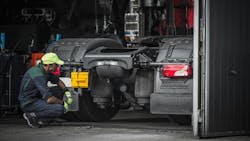The main concerns surrounding adding battery electric trucks to your fleet have often centered on range per charge, lack of charging stations, high cost of the vehicles, and maintenance changes.
A recent NationaLease meeting addressed that last concern regarding maintenance. Shaun Loftis, trainer at Autocar Trucks, talked about the new equipment needed for EVs and what safety concerns maintenance teams should be aware of. It’s true that standard maintenance items on an EV are fewer than those needed for an ICE, but it’s essential to remember that you are working with electricity. Last year, an article in FleetOwner noted that transitioning to EVs would be “a game-changer for people who run repair bays and oversee shop training.” The first and most important thing to remember for those working on these trucks is that electricity can be dangerous. Seems like an obvious thing to say, but if your maintenance team is not prepared with the right equipment and protocols, someone could get badly hurt.
According to the National Institutes of Health, “In the United States, there are approximately 1,000 deaths per year as a result of electrical injuries. Of these, approximately 400 are due to high-voltage electrical injuries.” To be fair, lightning causes most of these fatalities. However, the NIH report goes on to say that “there are at least 30,000 shock incidents per year that are non-fatal.” Five percent of those result in burn unit admissions.
The prime importance of PPE
With that in mind, you need to be sure your maintenance team has everything it needs to ensure safety. First, your team will need specific personal protective equipment for work on EVs. Loftis listed the following items:
- Safety glasses
- Rubber gloves
- Leather gloves
- Faceshield
- Apron
- 100% cotton clothes
Why 100% cotton? According to the Occupational Safety and Health Administration, when discussing the right material to protect electricians, “the best choice is 100% cotton work shirts because cotton is less likely to ignite as other materials.”
Loftis stressed the importance of ensuring your PPE meets specific standards, particularly the gloves. He noted that, regarding electrical rubber-insulating gloves, they “should be retested electrically once every six months using the test procedures described in the most recent editions of ASTM Standard F496 voltage rated insulating gloves.” Your maintenance team should also give the gloves a daily air test along with visual inspections. Do not use the gloves if there are any holes, tears, punctures, cuts or cracks, or if there is any other defect that could change the insulating properties of the gloves.
See also: Working together to ensure EV servicing safety
When it comes to other protective equipment, Loftis said that face shields and hard hats need to be inspected before each use and in accordance with the specs provided by the manufacturers. All other protective equipment should also be tested according to their specifications and standards.
Basic high-voltage safety steps
Loftis went through a series of steps that MUST be followed by those working on EVs to ensure safety:
- Never work on an EV while it’s charging.
- All repair and installation work shall be performed while the system is de-energized.
- Always wear safety glasses and electrical-insulated gloves covered with leather gloves.
- All jewelry should be removed whenever handling batteries, including rings, watches, pendants, necklaces, etc.
- Wear clothing that is 100% cotton when servicing any high-voltage system.
- Fasten long shirt sleeves at the wrists, and make sure shirts and jackets are closed at the neck.
- Make sure portable ladders have nonconductive side rails.
Is it time to outsource your EV maintenance?
The safety concerns regarding EV maintenance and the investment in training may lead fleets to decide to outsource maintenance. Look for a third-party contract maintenance provider that has qualified technicians who have significant experience working on high-voltage electrical systems on EVs.
If safety first is the mantra for fleets, that should include safety for your technicians as well as safety on the road.
About the Author
Jane Clark
Senior VP of Operations
Jane Clark is the senior vice president of operations for NationaLease. Prior to joining NationaLease, Jane served as the area vice president for Randstad, one of the nation’s largest recruitment agencies, and before that, she served in management posts with QPS Companies, Pro Staff, and Manpower, Inc.
